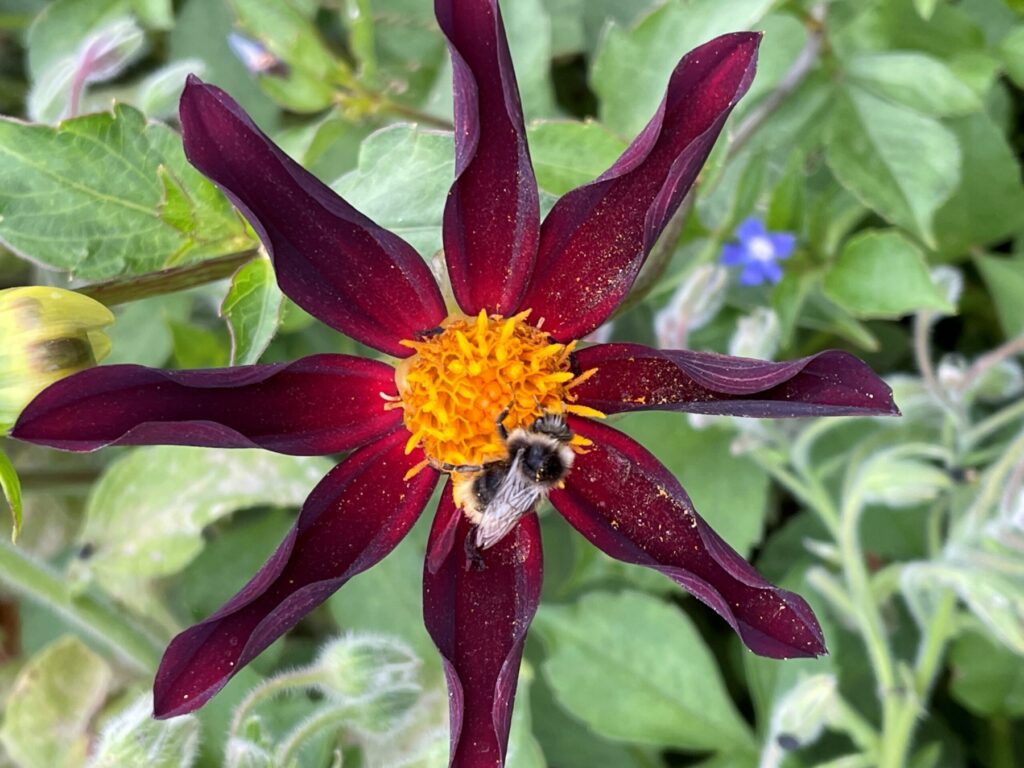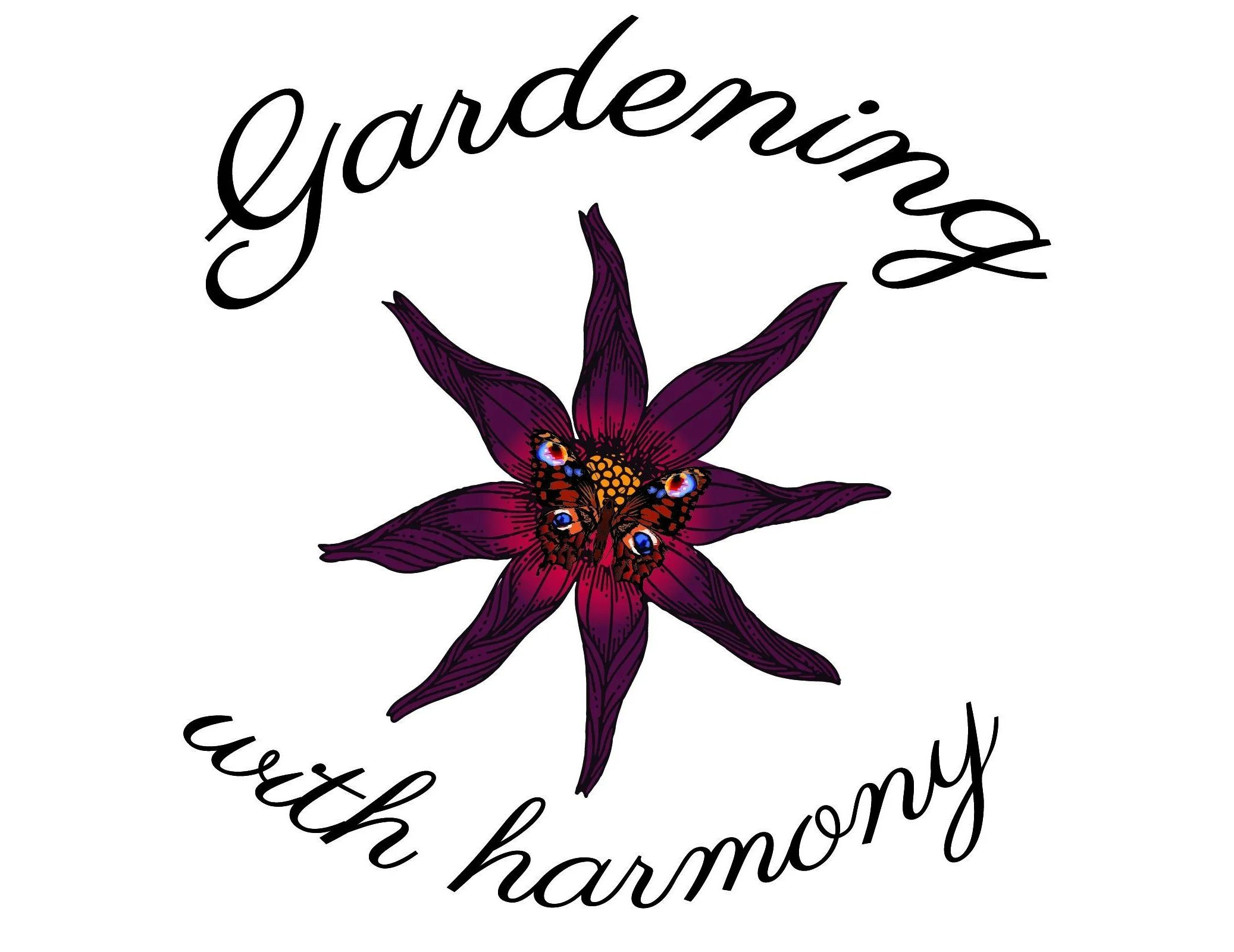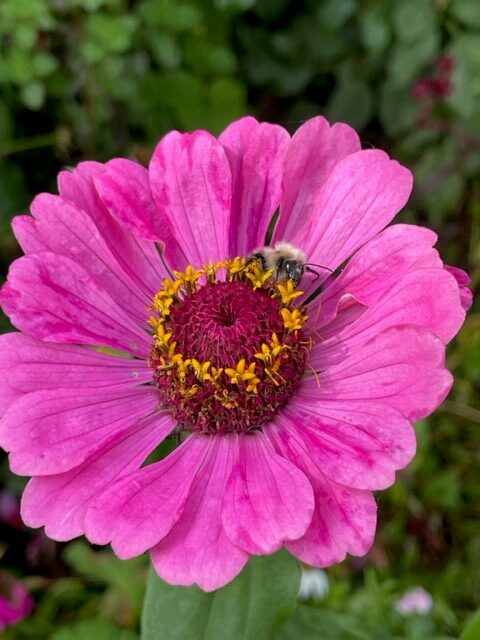I thought we should have another post on fantastic flowers for pollinators, to add to my earlier one.
In addition to the eight fabulous flowers I chose earlier, there are so many more that attract pollinators. Furthermore, they all add colour and beauty to our garden borders and pots so are well worth growing for us as well as our wildlife.
I have added a link below to the earlier post, if you have not seen it.
The best flowers for fantastic pollinators
As I mentioned last time, we have pollinators to thank for so much of what we eat. Not only do they pollinate our food crops, they are also vital for plenty of wild plants that in turn, support so much wildlife.
Moreover, they are a joy to watch in the garden. Especially when we know that we have provided the nectar, pollen and habitat they need to help them survive.
What a boost to wellbeing this gives us.
So here are another eight fantastic flowers for pollinators that I grow in my garden and hope you will grow in yours.
I am starting with some beautiful zinnias.
Zinnias, first flowers for pollinators

First for this post, the fabulous zinnia. Available in a variety of colours and shapes, they are all fantastic for pollinators.
My photo has a beautiful red admiral butterfly feeding on zinnia Purple Prince.
Although, this beauty is named Purple Prince, the flowers always look dark pink to me. However, the butterflies, bees and other pollinators do not care about the name clearly.
I sow this variety every year and am rewarded with beautiful blooms from July until late into October.
In fact, last year, Purple Prince still had a few blooms in November. In addition, I grow, Polar Bear, Envy, Californian Giant, Forecast and Whirligig.
My seed packets this year also include some new varieties that I have not grown before.
I look forward to sharing some photos of Queeny Lime Red and Zinderalla Peach later in the year. Fantastic names for some beautiful blooms in the making.
Clearly, I could not be without plenty of zinnias in my garden. Primarily for our all important pollinators, but also for their stunning beauty.
Furthermore, zinnias can cope with periods of hot, dry weather. And as our summers get drier, drought-tolerant plants are becoming increasingly important in our gardens.
Poached Egg flowers for pollinators

My next choice is the fantastic poached egg plant, (Limnanthes douglasii). A fantastic hardy annual which you can direct sow once the soil warms up in April.
I always sow plenty each year, to add to the thousands of self sown seedlings from the previous year’s plants.
In fact, last year the poached egg plants took over the edge of part of my lawn, commandeering an area measuring 14 foot by 4 foot (4.2m x 1.2m).
I did not mind, as the ribbon of colour looked fabulous and the area absolutely teamed with honey bees and hoverflies. A truly wonderful sight to see.
A low growing plant with cheerful yellow and white flowers.
However, if you are not keen on the yellow and white, there is an all white variety named Meringue.
Naturally, I grow a few of the Meringue as well.
Cosmos flowers

Next, we have the fabulous cosmos flowers again. They deserve a place on this post as they are absolute magnets for bees, butterflies, and other insects such as hoverflies.
Therefore, if you can plant one patch of these flowers in your garden border, or in pots, they will bring you plenty of grateful pollinators.
In addition, as cosmos has such an incredibly long flowering season, the pollinators will have a source of nectar for many months.
In fact, mine usually flower from as early as May until the first frosts which can be as late as December.
If you need some cosmos seeds, I have added links below with some options.
Cosmos seed options from Thompson and Morgan
Sarah Raven cosmos seed options
I will be growing thirty two varieties this year, so more cosmos posts will follow in the summer with my results and plenty of photos.
Honeysuckle

Next up, the fantastic fragrant honeysuckle. Normally flowering and climbing ever upwards from June till September.
I have several honeysuckles in my garden and can lose eons of time watching the pollinators and smelling the fabulous flowers.
Of course, there are many varieties in wonderful colour ranges and sizes to suit every garden.
Thompson and Morgan have several lovely honeysuckle options. Link below. I have my eye on Dart’s World. A beautiful scarlet trumpet of a honeysuckle to add to my collection. In addition, the trumpet varieties have restricted growth so would be fine in a pot, if space is at a premium.
Options for honeysuckle plants from Thompson and Morgan
I have also seen some lovely varieties on offer from J Parkers and have given a link below for honeysuckle and other fabulous plants.
There is a honeysuckle mixed collection of three different varieties and also a beauty called Gold Flame. Who can resist a mix of red and orange blooms, buzzing with bees. Plus, a fabulous fragrance in the garden too.
Another option would be Winter Beauty, fabulous for helping bees and butterflies over the winter. As the met office has recently announced that February was the hottest on record in England and Wales, pollinators are emerging earlier and need food.
In fact, a red admiral butterfly and a buff tailed bumble bee were often seen in my garden over the winter 12 Days Wild challenge from the 25th December to the 5th January. Links below if you missed these posts and want to take a look.
12 Days Wild, some festive Christmas magic 12 Days Wild, into the New Year
Allium flowers for pollinators

Next, it is the turn of the wonderful alliums.
There are so many different varieties, and my favourite is sphaerocephalon, seen above with some bees. A variety that flowers later than the others and is a wow for pollinators in my garden.
In addition, if you choose different varieties, you can have alliums in flower from May right up to the end of July, or even into August.
I have provided a link below to my earlier allium post with several fantastic varieties to grow.
Wonderful alliums for beauty and the bees
I grow alliums in my flower borders, and also in containers. They are also happy in pots if space is limited.
I purchase my alliums from J Parkers and have added a link below. There are varieties in purple, pink, white, yellow and even blue. So, plenty of colours to choose from and the pollinators will love them all.
Please click here for J parkers allium options
Magical Marjoram

My next choice is the fantastic marjoram.
This plant is best grown as an annual, as it is not reliably hardy in the UK.
However, my plants have made it through a harsh winter, surviving a week of minus seven a couple of years ago. I was checking my plants earlier today and they are all sending up fresh leaves, ready for the summer.
When they flower, from June till September, the delicate, pink flowers are a treat for butterflies, as well as bees, hoverflies and other pollinators.
I found that last year, whilst carrying out the Big Butterfly Count, my marjoram was covered in butterflies. Especially the lovely Gatekeeper, seen in the photo above.
In addition, marjoram is fantastic in the kitchen, used in baking and cooking, in soups and salads, and even in dressings and oils.
As these wonderful plants grow to a height of around 50cm, they are suitable for the fronts of borders as well as pots.
Malva flowers

Next, I have chosen some wonderful Malva, commonly known as mallow. I grow Mystic Merlin, which has fabulous silky blooms in shades from rich purple through to mauve, violet and blue.
Mystic Merlin is a splendid bushy hardy perennial plant. It boasts such attractive flower spikes. Naturally, I cannot resist this variety as they are coloured such a beautiful purple to deep violet with striking darker veins as seen above.
I think this one is a fantastic choice for flowers for pollinators, especially bees.
My malva, or mallow, with those eye-catching, cup-shaped flowers are often seen in my garden with a bee emerging from the blooms. Malva plants vary in colour from wonderful purple, pretty pink, dark red and fresh white, depending on the variety you grow.
They can reach a height of 1.5m and bloom from June till August. My malva Mystic Merlin was treated to a trim in August and sent up more flowers in September.
Phacelia flowers for pollinators

My last choice for this flowers for pollinators post is the fabulous phacelia. Also called scorpion weed, purple tansy and fiddle neck. What fabulous names for a fantastic flower.
Another great flower, beloved by bees and attractive to plenty of beneficial insects like lacewings and ladybirds. The rampantly hungry nymphs of both ladybirds and lacewings munch away on the aphids. Good news indeed.
Furthermore, phacelia is known as a green manure, one to be dug in to the ground to build up the organic content of the soil. However, as it is best to do this before it blooms, I prefer to leave the plants to flower.
I sow plenty of seed in flower borders and pots from March onwards. They flower six to eight weeks later. I then sow again at two of three week intervals for plenty of blooms throughout the summer.
As they self seed, they pop up year after year in my garden. However, if you do not want them to spread around, deadhead after they flower and before they set seed.
They can grow to a height of 1.2m so are best in a border. However, I do grow some in large pots as well.
Seeds and plants

Well, there ends my next batch of eight fantastic flowers for pollinators.
If you fancy growing some beautiful zinnias, I have added a link below. I already grow eight varieties, and most of those beauties can be purchased as seeds below. Along with plenty of other varieties too, in different colours.
Zinnia seed options from Thompson and Morgan
If you fancy some fantastic marjoram, I have given a link below for some seeds.
Marjoram seeds from Thompson and Morgan
For the phacelia or fiddleneck, seeds can be purchased below.
Phacelia seeds from Thompson and Morgan
These links can be used for all seeds, including poached egg plants and malva, as well as plants and bulbs.
I hope that you have enjoyed this post, and will grow some of these brilliant flowers and watch the pollinators fly in.
Wherever you have room in your garden, or courtyard, or balcony, these flowers for pollinators will thrive, providing you have a sunny area.
I hope to see you next time when I will have a post on companion gardening with my beautiful cat and fabulous rescue hens.
This blog is an affiliate for J Parkers, Thompson and Morgan and Sarah Raven. If you click on one of the links above, and make a purchase I may receive a commission, at no additional cost to you.
To see all my updates as they happen, please enter your email address below and press the subscribe button.



2 responses to “Flowers for pollinators, more fantastic blooms”
Love the name ‘fiddle neck.🤭 I definitely need Marjoram this year. I think that’s one of the few things on this post that I haven’t grown yet. Can’t wait for a lot more colour in the borders😊
Fabulous you will get some marjoram. The pollinators in your garden will absolutely love it. Agree with you on Fiddle Neck. It is a fantastic name for a plant. Not long now till we are awash with colour 😁